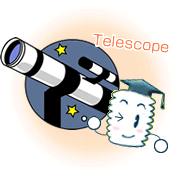
Episode 29: The world’s largest astronomical telescopes and springs
Hello everyone. According to the calendar, it is already fall. It is not only myself that finds many opportunities to view the sky in the fall. While it grows cooler, the sky becomes clearer, making easy to see the night sky. We are welcoming in the season in which amateur astronomers delight. In ancient times, mankind watched the stars and the moon and wondered about them. They created the constellations by connecting the dots, creating myths and academic materials. Today, thanks to scientific advances, we can see far into space. This is because astronomical telescopes have advanced a lot.

This telescope further increased its performance in July 2013. The camera at the end of the telescope was replaced. The new camera's angle of view is 7 times wider than that of the former camera. The camera is 3 meters in length. It weighs 3 tons. It is a digital camera with 870 million pixels. For your information, the camera used previously had only 80 million pixels. That makes the new camera 10 times as powerful in terms of pixels. What's even more impressive is that the camera position can move with an accuracy of 1 to 2 micrometers. What? You don't have a "clear picture" about micrometers? A "clear picture" is important when it comes to a camera. Sorry; that was a pun. Anyway, 1 micrometer is 1/1,000,000 of a meter. Got a "clear picture"? Well… The diameter of human hair is 60 - 80 micrometers. So, 1 micrometer is 1/60 - 1/80 of a human hair. Now isn't it amazing they can move the camera so precisely? So? Does this have anything to do with springs? That's what you want to ask, right? Yes, it does. As a matter of fact, a spring is used in order to adjust the angle of the big mirror of the Subaru Telescope. Usually, a drive unit called an "actuator" is used to move things in other telescopes and such devices. However, actuators do not offer the speed and precision needed when an object (such as a mirror) needs to be moved precisely in a telescope like the Subaru Telescope.

The light which reaches the earth from a star floating in space actually shakes slightly. The mirror has to be adjusted to respond to this shaking in order to obtain an accurate image.
By the way, aren't you interested in just what this spectacular Subaru Telescope is observing? It is studying "dark matter" and "dark energy." Oops, more hard words. Simply put, "dark matter" is something heavy that can go through anything. "Dark energy" is energy that is stretching the universe. The stars and galaxies known by humankind are called "ordinary matter", which accounts for less than 5% of everything that exists in the universe. The remaining 95%+ is invisible and consists of mysterious "dark matter" and "dark energy." So, why don't you look up at the sky and try to find these mysteries starting tonight? Well, that's all for today. For more information on dark matter, see Episode 4: "Springs in Space." See you next time! Written by Banekko (a child of spring)




